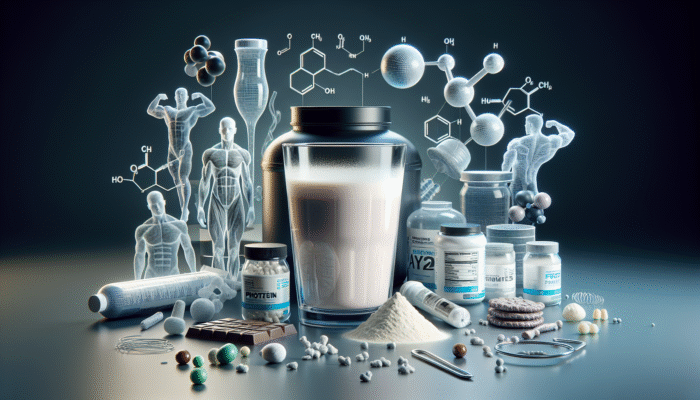Maximise Your Health by Unleashing the Nutritional Benefits of Whey Protein
Diving deeper into the rich attributes of whey protein highlights its well-deserved reputation as a top-tier nutritional supplement sourced from the liquid by-product of milk, which naturally separates during the cheese-making process. This remarkable ingredient transcends its status as a mere byproduct; it serves as a potent source of high-quality proteins that athletes, fitness aficionados, and health-conscious individuals rely on globally. By thoroughly examining the essential properties of whey protein, you can uncover a multitude of advantages, diverse applications, and a comprehensive understanding of this crucial dietary component that promotes muscle development and boosts overall health and wellness.
Discover the Exceptional Characteristics that Establish Whey Protein as a Nutritional Marvel

Whey protein, derived from the liquid segment of milk during the cheese-making process, undergoes meticulous processing to yield a premium protein source abundant in essential amino acids. The appeal of whey protein lies in its outstanding amino acid profile, crucial for facilitating muscle repair and development. In contrast to various other protein sources, whey protein is absorbed swiftly by the body, rendering it an ideal choice for individuals needing quick replenishment after intense workouts. This versatile ingredient finds its way into an array of products, including protein powders, bars, and countless food items, enabling individuals across the globe to conveniently boost their protein intake.
Your Definitive Guide to Selecting the Most Suitable Whey Protein Type
Grasping the different varieties of whey protein is essential for those eager to optimise their nutritional benefits. The three main categories encompass whey protein concentrate (WPC), whey protein isolate (WPI), and whey protein hydrolysate (WPH). WPC serves as the most fundamental variant, comprising approximately 70-80% protein, along with a modest amount of fats and carbohydrates. Its affordability and nutrient retention establish it as a popular selection among everyday users seeking a protein uplift. Conversely, WPI goes through additional processing to eliminate most fats and lactose, yielding a protein concentration of about 90%. This makes WPI an exceptional option for lactose-intolerant individuals or those aspiring to maximise protein intake without unnecessary calories. Lastly, WPH is pre-digested for rapid absorption and is frequently used in medical protein supplements and infant formulas due to its superior digestibility. Each type of whey protein caters to different needs, accommodating various dietary preferences and fitness objectives worldwide.
Exploring the Wide-Ranging Health Benefits of Adding Whey Protein to Your Diet
The health benefits associated with whey protein extend far beyond mere muscle gain; it is acknowledged as a multifunctional supplement that fosters muscle growth, accelerates recovery, and enhances overall wellness. For athletes, incorporating whey protein into their daily regimens can lead to improved performance and significant strength gains. Scientific studies have shown that consuming whey protein post-exercise effectively stimulates muscle protein synthesis. Furthermore, whey protein aids in weight management by promoting feelings of satiety, which can contribute to a reduction in overall calorie intake. Its rich supply of essential amino acids bolsters immune function and overall health, making it a preferred choice for anyone looking to enhance their vitality on a global scale.
Tracing the Intriguing Production Process of Whey Protein

The fascinating journey of whey protein, from farm to supplement, commences with the transformation of milk during the cheese production process. Gaining insight into the intricacies surrounding its extraction and processing is essential to appreciating the nutritional value of whey protein.
The Extraction Method for Whey Protein: The Crucial First Step Towards Purity
The extraction of whey protein transpires when milk is curdled during the cheese-making process. As curds develop, the remaining liquid is identified as whey, which is collected for further refinement. This liquid whey is an abundant source of protein; however, it necessitates careful processing to evolve into the supplement we recognise today. The extraction process must uphold a delicate equilibrium between preserving nutritional value and ensuring safety and quality. This pivotal initial step significantly impacts the overall quality of the final product, laying the groundwork for the nutritional powerhouse that whey protein ultimately becomes.
Utilising Advanced Processing Techniques to Enhance Product Quality
Manufacturers employ a variety of sophisticated processing methods to convert liquid whey into a highly effective protein supplement. Techniques such as microfiltration and ultrafiltration effectively separate whey proteins from fats and carbohydrates while maintaining the structural integrity of the protein itself. Additionally, the ion exchange method creates whey protein isolate, resulting in a product with a higher protein concentration and fewer impurities. Each processing technique provides distinct benefits, influencing the final product's taste, texture, and nutritional profile. By familiarising yourself with these methods, you empower consumers to make informed selections when choosing whey protein products that align with their health objectives.
Implementing Rigorous Quality Control in Whey Protein Production

Quality control holds paramount importance in the manufacturing of whey protein. Producers must comply with stringent safety regulations to ensure their products meet established nutritional standards. This process entails routine testing for contaminants such as heavy metals and pathogens that could jeopardise consumer health. The production process is meticulously monitored at every stage, from sourcing raw milk to final product testing, guaranteeing that every scoop of whey protein is both safe and beneficial. By understanding these rigorous quality control measures, consumers can rest assured that they are receiving a premium product that effectively supports their health objectives globally.
Revisiting the Varieties of Whey Protein: Tailoring Your Selection
Reassessing the different types of whey protein underscores the necessity of comprehending the distinctions between concentrate, isolate, and hydrolysate forms. Each type serves specific dietary needs and preferences. For instance, while concentrate acts as a cost-effective protein source for many, isolate is especially advantageous for those with lactose intolerance or individuals aiming to maximise protein intake while minimising carbohydrates and fats. Hydrolysate, recognised for its pre-digested format, is ideal for rapid absorption, making it a preferred option among athletes requiring immediate recovery solutions. By selecting the appropriate type, individuals can tailor their protein consumption to align with their individual lifestyles and fitness ambitions.
Investigating the Various Applications of Whey Protein in Everyday Life
The uses of whey protein extend well beyond the gym; it is a multifunctional ingredient incorporated into countless food products, including protein bars, fortified dairy items, and smoothies. Athletes utilise it to enhance muscle recovery, while health-conscious individuals integrate it into their diets for a protein boost without added calories. Additionally, food manufacturers exploit whey protein to enrich the nutritional profile of their offerings. By recognising the myriad applications of whey protein, consumers can uncover innovative ways to incorporate this nutrient-dense supplement into their daily routines, regardless of their location.
Assessing the Nutritional Composition of Whey Protein
Investigating the nutritional profile of whey protein elucidates why it has become an essential component in diets worldwide. It offers a plethora of health advantages.
Deciphering the Macronutrient Profile of Whey Protein
Whey protein is particularly distinguished by its impressive macronutrient composition, primarily characterised by an elevated protein content. Depending on its type, whey can contain anywhere from 70% to over 90% protein, making it an efficient source for individuals wishing to elevate their protein intake without excessive calories. With minimal levels of carbohydrates and fats, whey protein serves as an optimal supplement for those aiming to build lean muscle mass or effectively manage their weight. This distinctive composition has rendered it a preferred choice among athletes and fitness enthusiasts who rely on protein to fuel their performance and facilitate recovery.
Micronutrient Abundance: Contributing to Overall Wellbeing
Beyond its macronutrient profile, whey protein is rich in essential vitamins and minerals, significantly enhancing overall health. It contains substantial amounts of calcium, potassium, magnesium, and B vitamins, all of which are vital for various bodily functions. These micronutrients play crucial roles in energy metabolism, bone health, and numerous physiological processes. The nutrient-dense profile of whey protein positions it as more than just a protein source; it serves as a valuable ally in achieving optimal health and wellness, emphasising the significance of understanding whey protein fundamentals for anyone serious about nutrition.
The Digestibility and Rapid Absorption Rate of Whey Protein
A standout feature of whey protein is its remarkable digestibility and swift absorption rate. Research indicates that whey protein is absorbed more quickly than other protein sources, such as casein or soy. This rapid absorption is especially advantageous post-exercise, as it aids in muscle recovery and growth. For those eager to optimise their workout results or effectively manage their dietary needs, incorporating whey protein into their nutritional routines can significantly enhance overall performance. Its high bioavailability explains why whey protein is a globally recognised supplement among athletes and fitness enthusiasts alike.
The Amino Acid Composition: Critical for Muscle Development and Recovery
The amino acid profile of whey protein stands as another compelling reason for its widespread popularity. It is particularly rich in essential amino acids, especially leucine, which plays a pivotal role in muscle protein synthesis. This makes whey protein an ideal choice for individuals seeking to maximise their muscle size and strength gains. By thoroughly understanding the amino acid content of whey protein, users can better appreciate its role in supporting recovery and muscle development, allowing for more informed dietary choices.
Understanding Biological Value: Optimising Protein Utilisation
The biological value (BV) of a protein reflects how efficiently the body can utilise it for growth and repair. Whey protein boasts a higher BV than numerous other protein sources, making it an optimal choice for individuals seeking to enhance their muscle mass and overall health. A higher BV also implies that less whey protein is needed to achieve the same benefits as sources with lower bioavailability. Grasping this concept enables individuals to tailor their protein intake to meet specific health and fitness objectives, ensuring they maximise the advantages derived from their supplementation.
Discovering the Versatile Uses and Applications of Whey Protein
The versatility of whey protein positions it as a preferred option for various applications in sports, fitness, and general health.
Enhancing Athletic and Fitness Performance with Whey Protein
Within the vibrant realm of sports and fitness, whey protein emerges as a fundamental element. Athletes and fitness enthusiasts worldwide rely on whey protein to stimulate muscle growth, enhance athletic performance, and facilitate recovery. It is widely accepted that consuming whey protein post-exercise can significantly alleviate muscle soreness and accelerate recovery times. Numerous studies corroborate the efficacy of whey protein in enhancing athletic performance, solidifying its status as a staple in pre- and post-workout routines. For athletes, whether running marathons in Tokyo or lifting weights in Los Angeles, the advantages of whey protein transcend geographical boundaries, offering a universal solution for recovery and muscle development.
Whey Protein: A Powerful Ally for Weight Management and Healthy Living
Weight management is another area where whey protein excels. Research suggests that incorporating whey protein into a balanced diet can facilitate weight loss by increasing feelings of satiety, ultimately leading to a reduction in overall calorie consumption. Be it a busy professional in London or a student in Johannesburg, adding whey protein to your diet can support your weight management objectives without sacrificing nutrition. It serves as a strategic supplement for anyone looking to maintain or lose weight while preserving lean muscle mass. The satiating effects of whey protein become a valuable ally in the ongoing struggle against obesity and unhealthy eating patterns worldwide.
Promoting Holistic Health and Wellness with Whey Protein
Beyond fitness and weight management, whey protein plays a vital role in enhancing overall health and wellness. Its immune-boosting properties and potential to improve metabolic health make it a powerful addition to any diet. For example, research indicates that whey protein may assist in regulating blood sugar levels and reducing inflammation. These benefits can be particularly advantageous for individuals aiming to prevent chronic diseases, establishing whey protein as a staple for health-conscious individuals around the globe. Recognising these health benefits empowers consumers to leverage whey protein as a strategic tool for long-term wellness.
Essential Considerations for Choosing the Best Whey Protein to Suit Your Needs
With a plethora of options available, selecting the ideal whey protein can seem overwhelming.
Assessing Protein Content: Optimising Nutritional Gains
When evaluating a whey protein supplement, it is vital to thoroughly assess the protein content. Seek products boasting high protein percentages with minimal added sugars or artificial ingredients. The product label should clearly indicate the protein content per serving, allowing you to derive maximum value from your investment. Brands that provide transparent information about their protein sources assist consumers in making informed decisions. Understanding your fitness goals—whether it’s building muscle or supporting recovery—will guide you in selecting the most appropriate product, thereby enhancing your understanding of whey protein essentials.
Customising Selections to Address Individual Dietary Needs
Recognising your unique dietary needs is essential when choosing a whey protein supplement. Options such as lactose-free or vegan protein powders cater to specific dietary restrictions, ensuring that everyone can reap the benefits of this crucial nutrient. For instance, individuals with lactose intolerance might prefer whey protein isolate, which contains minimal lactose, while those adhering to a vegan lifestyle may explore plant-based alternatives. Carefully examining product labels for dietary compatibility empowers consumers worldwide to select the best option that aligns with their nutritional requirements.
Prioritising Product Quality: Making Enlightened Choices
The quality of the product significantly influences the selection process. It is wise to choose whey protein from reputable brands known for their commitment to quality standards and transparent sourcing practices. Look for customer reviews and certifications from third-party testing to ensure reliability. Such diligence guarantees the integrity of the supplement, safeguarding consumers' health. By emphasising product quality and maximising health benefits, individuals can confidently incorporate whey protein into their diets.
Innovative Methods for Integrating Whey Protein into Your Daily Nutrition
Incorporating whey protein into your daily routine can be both enjoyable and nutritionally rewarding.
Crafting Delicious Whey Protein Shakes and Smoothies
Whey protein shakes and smoothies offer a simple and convenient way to enhance your protein intake. Blend together your preferred fruits, vegetables, and a scoop of whey protein for a nutrient-rich beverage. Whether you favour a classic banana and peanut butter shake or a refreshing tropical mango smoothie, the possibilities are virtually endless. Adding whey protein to your morning smoothie can energise your day while delivering essential nutrients. This approach not only delights your taste buds but also ensures you receive the nourishment required to sustain your active lifestyle.
Enhancing Culinary Creations with Whey Protein for Healthier Meals
Integrating whey protein into your cooking and baking adventures elevates nutritional value without sacrificing flavour. To boost protein content, consider enriching pancake batters, muffin mixes, or even soups with whey protein. This versatility enables you to create healthier versions of your favourite dishes while keeping them delicious. Exploring innovative culinary applications for whey protein can transform your meals into protein-rich delights, allowing you to savour every bite while enjoying the many benefits of this exceptional supplement.
Creative Snack Ideas Featuring Whey Protein
Snack time can also serve as a fantastic opportunity to incorporate whey protein. From protein bars to energy bites, countless methods exist to create satisfying snacks packed with protein. Crafting homemade protein balls with oats, nut butter, and whey protein can provide a quick energy boost between meals or after workouts. These snacks not only deliver essential nutrients but also help curb hunger, simplifying adherence to your dietary objectives.
Integrating Whey Protein into Daily Meals for Nutritional Enhancement
Beyond shakes and snacks, whey protein can enrich the nutritional profile of numerous everyday foods. Adding it to yogurt, oatmeal, or smoothies can amplify these staples, making them more filling and protein-rich. Thanks to its mild flavour, whey protein mixes seamlessly into various dishes, allowing you to enjoy health advantages without compromising taste. This adaptability makes it easier to increase protein intake, supporting your health journey wherever you may be.
Exploring Exciting Recipes Featuring Whey Protein
Embarking on a culinary journey by experimenting with creative recipes utilising whey protein can be both enjoyable and rewarding. The opportunities are boundless, from protein-packed brownies to smoothies and protein-infused soups. The trick is to modify your favourite recipes, incorporating whey protein to enhance both nutrition and flavour. Engaging with whey protein in inventive ways not only boosts your health but also transforms healthy eating into an enjoyable and fulfilling experience, showcasing the versatility of this remarkable protein source.
Meal Planning with Whey Protein for Nutritional Success
Meal planning can seamlessly incorporate whey protein to ensure you meet your dietary requirements throughout the week. By organising meals that include whey protein, you can effectively manage your protein intake while streamlining your nutrition. Whether preparing a week's worth of protein-rich breakfast smoothies or planning lunches featuring whey protein-infused salads, the goal is to prioritise healthy eating. This structured approach allows you to reap the benefits of whey protein without feeling overwhelmed by dietary decisions.
Experimenting with Flavours for a Wholesome Protein Experience
Experimenting with various flavours of whey protein can keep your diet fresh and exciting. With a wide array of flavour options—from classic vanilla and rich chocolate to fruity variations—there is something for everyone. Mixing different flavours into your meals can provide delightful twists, making protein intake enjoyable. By rotating flavours, you can maintain enthusiasm for your nutrition, reinforcing the habit of consuming whey protein daily.
Building Community Through Sharing Ideas and Recipes
Don’t hesitate to share your ideas and recipes with friends and family. Engaging with your community about whey protein can lead to collaborative meal prep sessions, recipe sharing, and valuable tips on integrating this essential nutrient into everyday life. Establishing a support network around health and nutrition can enhance motivation and foster a sense of camaraderie, making the journey toward better health a shared and enriching experience.
Establishing a Balanced Approach to Nutrition for Optimal Health
Formulating a balanced approach to incorporating whey protein into your diet is crucial. Aim for a healthy mix of protein sources to ensure you receive a variety of nutrients while achieving your protein goals. By understanding the fundamentals and exploring the numerous ways to enjoy whey protein, you can develop a sustainable nutrition strategy that supports your overall health journey and enhances your quality of life.
Addressing Common Queries Regarding Whey Protein
What is whey protein and how does it work?
Whey protein is a high-quality protein derived from the liquid segment of milk that separates during cheese production. It is renowned for its muscle-building and recovery benefits.
What types of whey protein can I find on the market?
The three primary varieties of whey protein include concentrate, isolate, and hydrolysate, each differing in protein content and processing methods to cater to diverse dietary needs.
What benefits can I expect from regular whey protein consumption?
Whey protein encourages muscle growth, aids in recovery, supports effective weight management, and enhances overall health, making it a favoured choice among athletes and health enthusiasts alike.
How is whey protein processed to ensure its quality?
Whey protein is extracted during cheese production and subsequently processed using advanced techniques such as microfiltration and ultrafiltration to enhance its purity, flavour, and protein content.
How does the digestibility of whey protein compare to other protein sources?
Whey protein is highly digestible and absorbed rapidly by the body, making it a practical choice for muscle recovery and growth following physical activity.
Can whey protein assist in my weight loss journey?
Absolutely, incorporating whey protein into a balanced diet can promote feelings of fullness, reduce calorie intake, and support effective weight management strategies.
How can I choose the best whey protein for my specific needs?
When selecting whey protein, evaluate the protein content, consider any dietary restrictions, and assess product quality to ensure you choose the best option for your health and fitness objectives.
What are some simple methods to add whey protein to my diet?
Whey protein can be effortlessly integrated into shakes, smoothies, baked goods, and snacks, boosting protein content while retaining delicious flavours.
Is whey protein safe for everyone to consume?
While whey protein is generally safe for most individuals, those with lactose intolerance or allergies should opt for lactose-free alternatives or different protein sources.
When is the optimal time to consume whey protein for maximum benefits?
The best times to consume whey protein are immediately post-workout for recovery or as a meal supplement throughout the day to help meet your protein goals.
Connect with us on Facebook!
The article Understanding Whey Protein Basics: A Comprehensive Guide appeared first on https://athleticsupplement.com
The article Whey Protein Basics: Your Essential Guide to Nutrition was found on https://limitsofstrategy.com
The Article Whey Protein Basics: An Essential Nutrition Guide found first on https://electroquench.com

